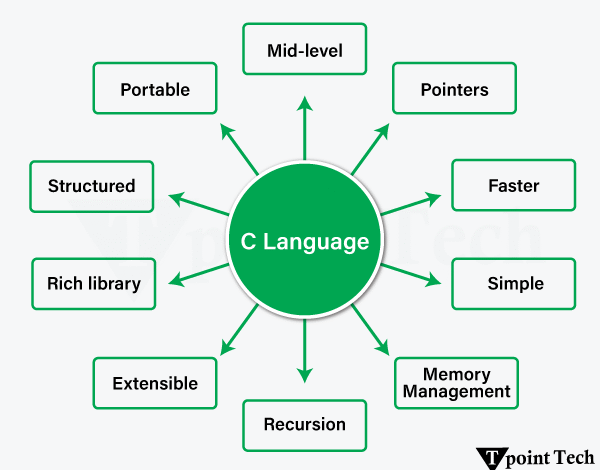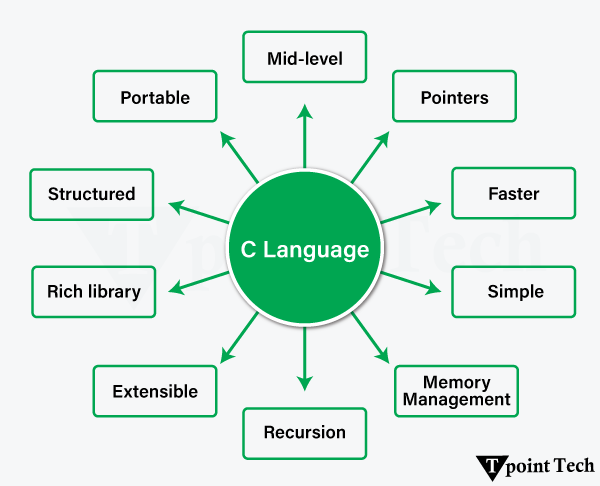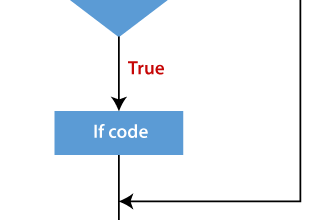Features of the C language –

|
C language is one of the most widely used and important programming languages since its development. It was developed in the early 1970s by Dennis Ritchie at Bell Labs. It was designed to allow programmers to use both high-level programming and low-level access to hardware. It has a simple syntax, structured programming, and a large number of operators, which makes it an essential programming language to develop system software, operating systems, and compilers. C programs are very portable and are easily modified to run on another machine. C provides direct memory access via pointers, supports modular programming in the form of functions, and a wide variety of data types and control structures. The C standard library also includes built-in functions for input/output, string handling, memory allocation, and deallocation. For these reasons, C’s speed, reliability, and flexibility have made it the foundation for many modern programming languages (such as C++, Java, and Python), and it is still an essential and useful programming language today. Main features of the C Programming LanguageThe C language is a powerful programming language that supports high-level structured programming principles with low-level memory access, which makes it efficient and simple. Its huge library support offers several built-in functions for routine processes, and its portability enables applications to operate on various machines with minimal modification. The C programming language provides several important features that help to make a program more efficient. Some main features of the C language are as follows:
Here, we will discuss these features one by one. 1) SimpleC is a simple language because it provides a structured approach, a rich set of library functions, data types, etc. It is simple language due to its hierarchical structure, simple syntax, and a small number of reserved words. It is easy for beginners to understand and use because it has several features for more experienced users and lacks complex concepts such as classes or objects. ExampleCompile and Run Output: Hello, C is a Simple Programming Language! 2) Machine Independent or PortableUnlike assembly language, C programs can be executed on different machines with some machine-specific modifications. Therefore, C is a machine-independent language. It is possible because C provides a standard library and well-defined syntax that can be recompiled on several platforms. As a result, developers can write C applications that are easily adaptable across different hardware and operating systems. 3) Mid-level Programming LanguageC is a mid-level programming language because it combines the features of both low-level and high-level languages. Like assembly language, it employs pointers to control hardware and shares the same functions, structures, and data types as higher-level programming languages. As a result, C can be used to develop system and application software. 4) Structured Programming LanguageThe C programming language is a structured programming language because it enables large programs to be broken down into smaller, more manageable components called functions or modules. This modular technique helps to reduce code redundancy, which makes debugging and testing easier. C programming also provides code reusability, as modules and functions can be reused in other projects or applications. 5) Rich LibraryStandard libraries for C, such as stdio.h, math.h, and string.h, preserve many of the built-in functions of the language. These libraries help us to perform several mathematical operations, including text manipulation, mathematical procedures, and input/output handling. It takes less time to develop and requires less writing of code from scratch. 6) Memory Management:The C programming language supports the feature of dynamic memory allocation functions (such as malloc(), calloc(), realloc(), and free() function). In the C language, we can free the allocated memory at any time by calling the free() function. Using the memory effectively is an essential feature of low-level system programming. 7) Fast SpeedThe C programming language is a faster and efficient programming language because it gives low-level access to memory. It makes the compilation and execution of code faster due to its compiler-based language. Due to the compiler-based program, its execution is faster than that of interpreter-based languages in C. 8) PointersOne of the best features of C is using pointers to store the address of a memory location, without keeping the data with that memory location. Pointers can help to directly interact with the memory. Pointers can be utilized in many circumstances, such as a part of a data structure (for instance, linked lists and trees), interaction with arrays, as part of function use, memory allocation, and certainly to gain speed in execution and memory usage. 9) RecursionC supports recursion, which means that a function can call itself as part of a solution to a problem. It is useful for problems that can be separated into smaller problems, such as factoring numbers, the Fibonacci series, or tree traversals. In some cases, recursion can help to make programs much shorter and simplify the logic into more complex processes. 10) ExtensibleC is an extensible language, which means that it enables us to add new functionality or do something new to an existing program. It allows complete flexibility to make adjustments to meet new requirements. Therefore, C is a useful language when developing scalable applications that need to be used long-term. ConclusionIn conclusion, C is a powerful, efficient, and general-purpose programming language that is very useful in the development of many aspects of modern computer programming. Even beginners and experienced developers can benefit from the important qualities through its simple, portable, structured, and library-supported programming language. More advanced features, such as dynamic memory allocation, pointers, recursion, and extensibility, provide programmers with more flexibility to develop applications on both the system-level and application-level. Its speed, versatility, and foundational principles make it an ideal choice for more advanced languages like C++, Java, and Python. C Features FAQs1) Why does the C language have the characteristics of both high and low-level languages? The C programming language combines the features of both low-level languages (e.g., addressing memory with pointers) and high-level languages (e.g., functions, user-defined data typed structures, and structured programming). 2) Is the language C a non-machine-dependent language (or portable)? Yes, the C programming language is a portable language because it can execute its program in different systems with small modifications or no modifications. It helps to make the code more highly portable. 3) Why is the C language a structured programming language? C is a structured programming language that allows a large program to be broken down into smaller self-contained modules (or functions). It is easier to understand the whole program. It is more practical to debug a smaller module, and easier to test a smaller module. It is easier to reuse a smaller module. 4) Is C capable of managing the memory? The C programming language is efficiently used to manage memory using the dynamic memory allocation functions, such as malloc(), calloc(), realloc(), or free(). Using these functions in combination with pointers, the programmer can manage and use memory in a much more effective way and provide control of the system memory. 5) Why is the C language a popular programming language, even today? The C programming language is a simple, efficient, and portable way for a programmer to interact with the hardware. C language is often regarded as a foundation programming language for knowledge of advanced programming languages, such as C++, Java, or Python. C language is known to be popular in Operating Systems development or in embedded systems development. Next TopicHow to Install C
|




